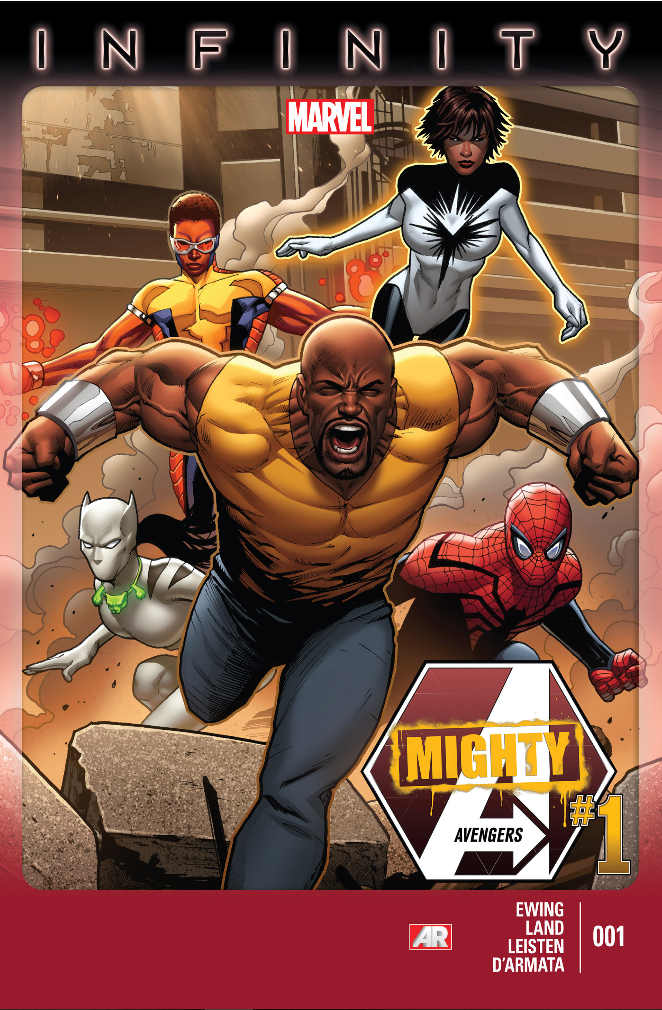A look at the Marvel comics of Al Ewing, part 1
A look at the Marvel comics of Al Ewing, part 2
Ultimate
We saw in New Avengers where White Tiger and Power Man ended up after Mighty Avengers, but what about the rest of the team? Well, Blue Marvel and Spectrum join the Ultimates, the first version of this team to exist in the mainstream Marvel U.
They are joined by Captain Marvel, Black Panther, and Miss America.

They are meant to be a team that solves the big problems, that are proactive, that tackle the problems that require the smartest, best thinkers and those with experience dealing with crazy.
It’s a fantastic line-up and one that stays more or less intact throughout this run and the one that follows. I would have loved to have seen occasional guest star the new Giant Man join in some capacity and it seems like Ewing was headed in that direction, but we never get there.

The book is firmly rooted in the cosmic side of the Marvel U, which is really the final step in Ewing’s story. We’ve now gone from the community rooted Mighty Avengers to the global superheroes of the New/U.S. Avengers, and now to the universe spanning (and beyond) adventures of the Ultimates. It’s a great evolution and showcases Ewing’s abilities to write at any level.
The Ultimates are put together by Captain Marvel to fix big problems and they start off with one of the biggest: Galactus. Ewing’s take on Galactus is great. He fleshes out his origin, gives his existence context within the greater Marvel cosmic universe, and then does the unthinkable: makes him a force for good.
The ideas and adventures in the Ultimates stand side by side with some of the best 70s Marvel stories, which is probably the biggest compliment I could give the series.
The first six issue comprise an epic story centered around Galactus, but that spans well past him. We also learn very quickly that with all these long standing Marvel heavy hitters, Miss America is perhaps the most important.
The back half of this twelve issue series features an apparent inevitability for Ewing: a crossover. However, this could be the finest work Ewing has done incorporating an event into one of his books. Captain Marvel plays a pivotal role in Civil War II and Ewing takes full advantage of that, doing a better job with her character than the main series does.

It’s easy to see how the team would fall apart during Civil War II. Captain Marvel wants to be proactive to the point of arresting people before they commit crimes. That’s not something Black Panther would ever be able to stand for. The division doesn’t even split the team in half so much as put everyone at odds with Captain Marvel.
The first series ends with the team going their separate ways.
Squared
Ewing has made a lot of deep dives into Marvel history over the course of his many Avengers books, but he saves the deepest dive for his final story.
Ultimates 2 (although made to look like Ultimates Squared) starts with the band getting back together. While Captain Marvel is trying to patch things up on her own, Miss America has already decided they need to be a team again because they have a job to do.
Miss America has never been as fully utilized as she is in the Ultimates. Her power levels are off the charts and we get enough information about her past to know that she has more experience dealing with inter-dimensional cosmic insanity than that rest of the Ultimates combined. Ewing only gives us hints as to what her life has been like, hints that would turn into one hell of a comic if they were ever dug into.
The deep dive comes in the form of the Troubleshooters, a group made up of new versions of New Universe characters. For those of us who read New Universe books during our early comic book reading days, this is wonderful. The new versions aren’t echoes of what came before, but fully realized alternate manifestations with their own fascinating back story.
And just to keep the other universe feel, Ewing even brings back the original Ultimates, the ones who had just been erased during Secret Wars.

I’m not sure if bringing back the Ultimate was always a part of Ewing’s plans or if he felt the need to include them given that the final issue of Ultimates 2 is renumbered as #100, not #10, so as to include every issue of the Ultimate universe runs as well. It’s a thin connection even with the original team making an appearance.
It’s The Maker who brings back the original Ultimates, which makes perfect sense since he’s been the major villain since New Avengers. Blue Marvel’s history also plays a big part in getting us to the finale. Honestly, the only thing missing is the Plunderer.
It’s a perfect finale for his run, the perfect ceiling to a room he built from the ground up.
It’s just a shame that there was a ceiling at all.








